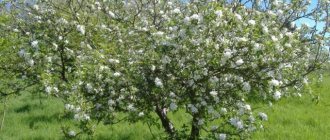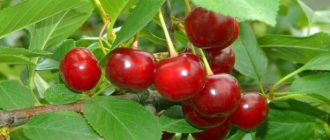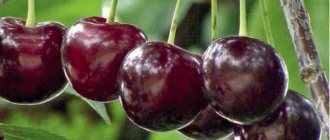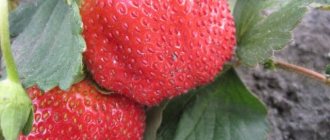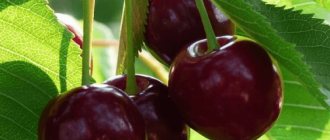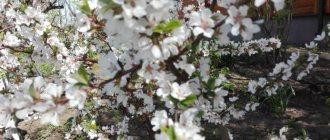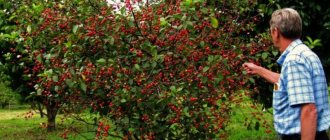Description of Podbelskaya cherry
The variety is quite old; it was bred back in the 19th century in Germany by breeder Karl Koch, who crossed the Lotova cherry and the Griot Ostheim cherry. Testing of the variety continued for quite a long time, and in Russia it was zoned in 1947 for the warm North Caucasus region.
The variety is recommended for cultivation in the North Caucasus and other southern regions
Podbelskaya is a fairly tall tree with a rounded dense crown, prone to flattening with age. The branches and shoots of the tree are covered with gray-brown smooth bark and longitudinal cracks, the shoots are directed upward and slightly bend when fruit appears. The leaves of the cherry are large, up to 6 cm wide and 12 cm long, broadly oval, green in color, matte and slightly fleecy.
Podbelskaya blooms in small inflorescences consisting of 3-4 white flowers with rounded petals up to 3 cm in diameter. The fruits are held on small, short petioles.
Important! According to the description of the variety, Podbelskaya cherry produces shoots at the roots, and quite actively. This is both an advantage and a disadvantage of the variety; the shoots allow you to easily propagate cherries, but at the same time you have to make sure that they do not grow too much.
The height and diameter of the crown of the Podbelskaya cherry
The height of an adult fruit tree is on average 5 m. The crown is dense, widely leafy, and can reach 2 m in diameter, especially in an adult tree with significant growth.
The tree can grow quite high - up to 5 m
Description of fruits
From the photo of the Podbelskaya cherry variety and from the description of the variety, it can be established that the plant bears large flat-round berries, weighing up to 6 g. The color of the fruits is burgundy, almost black, the pulp of the berries is fibrous, but at the same time very juicy, dark red in color and sourish-sweet taste. The pulp separates well from the cherry pit. The taste of the fruit is considered dessert - the tasting score ranges from 4.8 to 5 points, for which gardeners especially value the variety.
Since Podbelskaya is a heat-loving variety and feels very good in the sun, its fruits do not bake under the sun’s rays and remain juicy. Ripening occurs unevenly and is extended over time, but ripe berries stay on the petioles for quite a long time, so you don’t have to rush into picking.
Podbelskaya has a very sweet, dessert taste.
Podbelskaya cherry pollinators
Podbelskaya belongs to the early flowering varieties and usually blooms in early May if it is grown in a warm region. Gardeners need to take into account that the variety is self-sterile - without pollinators, fruits cannot be expected.
The English Rannyaya, Lotovaya, Anadolskaya, and Griot Ostgeimsky varieties are well suited for pollination of Podbelskaya. All of these cherries bloom at similar times, and planting them side by side in the garden area will be very beneficial.
History of selection and region of breeding
The variety was obtained in the 19th century in Germany as a result of crossing the Lotovaya variety and Griot Ostheimsky. The author of Podbelskaya is the German botanist and breeder Karl Koch.
The new variety successfully passed tests, was zoned in 1947, and included in the register for the North Caucasus region. In the literature there are other names for Podbelskaya: Minister Podbelsky, Kokhova.
The varieties Chernaya Krupnaya, Shalunya and Igrushka are also well suited for cultivation in this region.
Main characteristics
Before planting Podbelskaya on a suburban area, you need to study its main features. This will help you decide whether it is worth the effort to grow the tree.
Drought resistance, frost resistance
Podbelskaya tolerates short-term dry periods well. A lack of water for this sun-loving tree is much better than an excess of moisture; the plant reacts sharply negatively to waterlogging.
The variety practically does not tolerate frost even in the middle zone
But Podbelskaya is very sensitive to frost. It does not tolerate even mild frosts well, so growing it in the Moscow region and the middle zone is associated with certain difficulties. The plant feels best in the North Caucasus and Crimea, where winter temperatures remain mild.
Productivity
According to the ripening period, the Podbelskaya cherry variety belongs to the early-medium category. In Crimea and the Caucasus, fruits can be harvested already in mid-June, in the middle zone - in early July. For the first time, Podbelskaya begins to bear fruit 4 years after planting in the ground.
Yield indicators depend primarily on the presence of pollinators. Since the variety cannot bear fruit on its own, high-quality pollination is very important for a good harvest. Also, the number of fruits depends on growing conditions, watering and whether some of the flower buds died during the spring frosts. In good circumstances, Podbelskaya cherry is capable of producing 30-40 kg of berries from one tree, sometimes up to 50-60 kg.
Attention! The yield of Podbelskaya depends, among other things, on age - young trees do not bear fruit very abundantly, the variety reaches its maximum values by 12-15 years.
The variety reaches its maximum yield at 12-15 years of age.
The transportability of cherry fruits of this variety is normal, average; the cherries are suitable for storage, but for a limited period. Podbelskaya has a universal use - the fruits are suitable for fresh consumption, for preservation for the winter, for making juices and compotes.
Advantages and disadvantages
Having studied the features of Podbelskaya, we can highlight several main advantages of the variety:
- dessert taste of the fruit, deserving the highest tasting rating;
- good yield;
- the versatility of fruits and their suitability for transportation for sale;
- relative resistance to most fungal diseases.
At the same time, Podbelskaya has its own shortcomings. The main one can be considered low frost resistance. Cherry feels good in the southern regions, but in the middle zone it can freeze, and growing it in Siberia does not make sense at all - the tree will die from frost. Another disadvantage of the variety is its self-sterility; without pollinators, Podbelskaya will not bear berries at all.
Harvest and storage
A clear day is chosen to harvest cherries. Dry berries are easier to pick and last longer. If you plan to transport cherries, then remove them 2-3 days before they are completely ripe. This should not be done earlier, since berries that are too unripe will not ripen outside the tree and will be hard and sour. For transportation, cherries are harvested with the stalk intact. The petioles do not need to be saved for consumption and processing.
If the size of the plot allows you to place such a large cherry tree as “Podbelskaya” on it, then you can do it without hesitation. With such volumes of harvests, there may not be a need to plant other cherry trees. In addition, Podbelskaya cherries are long-lived and can produce crops for 25 years or more.
How to plant Podbelskaya cherry
Gardeners who decide to grow cherries need to study Podbelskaya’s requirements for planting and care. Growing the variety is not particularly difficult, provided that the tree grows in a warm climate.
The tree should be planted in a sunny area.
Recommended timing
Both in the middle zone and in the south, it is recommended to plant Podbelskaya in the spring - in April, after the snow has melted and the soil has warmed up. Since cold weather is very dangerous for the variety, autumn planting of cherries is not practiced; usually it does not have time to take root before the onset of winter.
Site selection and soil preparation
It is necessary to plant a tree in a well-lit place - Podbelskaya loves the sun and does not tolerate its deficiency. It is best to choose a place on a hill; it is unacceptable to plant cherries near groundwater, in which case the soil will always be swampy and the tree will die.
Before planting, you need to dig a deep hole about 50 cm deep and wide. The extracted soil must be mixed with humus, add 1 kg of wood ash, 20 g of potassium chloride and 30 g of superphosphate.
Advice! If the soil on the site is clayey and too damp, you can add a bucket of sand to the soil before planting, which will ensure soil drainage.
Landing algorithm
The procedure for planting cherries looks very simple:
- The prepared mixture of soil, humus and fertilizers is poured halfway into the hole.
- The seedling, previously soaked for a couple of hours in water, is lowered into the hole and covered with earth to the surface of the ground.
- Immediately after planting, pour 2 buckets of water under the trunk and mulch the soil with sawdust or compost.
Before planting, drainage is organized for the seedling and fertilizing is applied to the soil.
When planting cherries, the root collar should be at ground level; it cannot be deepened into the ground.
Landing
Before planting Podbelskaya cherries, you need to select healthy seedlings. Signs of a quality seedling:
- the growth of a young shoot is no more than 1.85 meters;
- developed root system;
- at a level of ten to fifteen centimeters above the root collar there is a tubercle - the grafting site;
- without foliage;
- on a trunk - no more than 8 shoots up to twenty centimeters long;
- healthy roots (they don’t crunch when wrapped around your finger, they feel moist to the touch;
- shoots do not break when bent.
It is undesirable to plant a tree in a lowland, since due to the accumulation of melt water, the roots may rot and the buds may freeze. If the planting site is low, build an earthen embankment.
Sand, humus and mineral fertilizers - superphosphate, ash, potash fertilizers - are added to the clay soil on the site. The depth of the landing groove is half a meter. When planting, make sure that the root collar is at ground level. After the seedling is covered with soil mixture, it is watered abundantly (at least 2 buckets of water) and then mulched with organic or inorganic materials.
If mineral fertilizers are added to the soil under the Podbelskaya cherry seedling during planting, then in the next 2-3 years the tree does not need fertilizing. Cherry is quite unpretentious in care, but you should not forget about some measures. This is regular loosening of the soil in the tree trunk circle, removal of weeds and collection of fallen leaves in autumn.
Features of care
Caring for Podbelskaya cherries is quite simple. During the growing process, you need to adhere to the basic rules of watering, pruning and fertilizing.
Watering and fertilizing schedule
You need to water the tree with great care - too much water can cause the fruits to crack and begin to rot. It is recommended to moisten the soil under the cherry trunk only during periods of severe drought during flowering, ovary formation and fruiting.
As for fertilizers, for the first time mineral fertilizing is applied directly at planting. After this, Podbelskaya does not need to be fertilized at all for 2-3 years. Subsequently, cherries can be fed with potassium and phosphorus during fruiting and nitrogen during flowering.
Trimming
It is recommended to prune cherries annually for sanitary purposes and to eliminate root growth. Most pruning is carried out in early spring, removing shoots and broken, dried branches.
In the fall, the tree is inspected again and, if necessary, dead shoots are cut off again, and the ground around the trunk is thoroughly cleaned of plant debris.
Every autumn the tree needs to be pruned and shoots removed from the roots.
Preparing for winter
Podbelskaya needs especially careful shelter for the winter, since it does not tolerate cold weather. With the onset of autumn, the area is cleared of fallen leaves and dry branches, and the tree trunk is whitened to prevent cracking of the bark and attacks by pests.
In winter, the soil under the cherry tree trunk must be mulched with a dense layer of sawdust or compost. First, 20 liters of water are spilled on the ground. Young cherries should also be wrapped in burlap or cardboard to prevent the trunk from freezing.
Appearance of Lebedyanskaya cherry
Let us consider separately the appearance of the tree and the fruit.
Tree
The cherry tree is considered fast-growing because it reaches a meter mark in a year. He is tall - up to 3.0-3.5 meters. Comparable in growth to this variety are the Volzhskaya Krasnitsa plum and Gera and Victoria pears.
Requires professional crown pruning. The crown of the plant is in the form of a pyramid. The foliage is dense.
The bark on the main branches and short trunks has a chestnut tint. The shoots are dark brown in color, large in size, with a small number of lentils.
The buds are large, round-ovoid in shape, slightly deviated from the branches. The foliage is large, oval-rounded with a dark emerald hue. It has a shining double-crest serration and a flat, smooth topography. There is no pubescence.
The leaf petioles have an anthocyanin tint. The weight and elongation of the petioles are medium in size. At the end of the leaf plate there are 1-2 small glands. The color of the glands is burgundy.
The leaf blades are elongated in shape with a weak dissection. They fall late. Fruit bearing occurs on bouquet productive stems.
Diseases and pests
Podbelskaya cherry demonstrates good resistance to coccomycosis, chlorosis and other fungal diseases - this is one of the advantages of the variety. However, the tree can be affected by monilial burn, which is dangerous for cherries, and suffers from common insect pests - aphids, cherry flies, sawflies.
To prevent and treat diseases, it is recommended to preventively treat the tree in the spring with Bordeaux mixture and azophos. It is also necessary to regularly dig up the soil at the roots of the cherry tree, whiten its trunk from time to time and treat all cracks and wounds on the trunk and shoots with copper sulfate.
Pros and cons of the variety
The advantages of this beautiful tree include a relatively high degree of resistance to various diseases, in particular fungal ones. Cherries also please their owners with good productivity and ideal taste qualities of fruits that have dessert and technical purposes. In the southern regions, this fruit tree grows well and produces a large harvest, while in the northern regions it can suffer from frost and burns, and annual tree shoots and generative buds may freeze.
By nature, Podbelskaya cherry is a cherry-cherry hybrid that resembles a simple cherry. The variety also has an average degree of resistance to hot and dry weather. Ripe fruits stick quite well to the tree. Ripening time: end of June – beginning of July. The disadvantages include the large size of the fruit tree, as they can somewhat complicate the procedure for caring for it, ripening the fruits and harvesting.
Selection of seedlings
Podbelskaya cherry seedlings
To get a healthy cherry tree, first of all you need to pay attention to the quality of the seedling itself. What characteristics should it have:
- One-year-old seedling no more than 185 cm high.
- The grafting site is located 10-15 cm above the root collar - it looks like a slight curvature on the trunk.
- The root system is well developed and powerful.
- The number of shoots should not exceed 8 pieces, and the length of each of them should not be more than 20 cm.
- The presence of deciduous mass is excluded.
Important to know: pay attention to the health of the planting material. Wrap the root around your finger – it should feel damp to the touch and not make a crunch when you roll it up. The shoots respond well to bending, do not crunch, and at the point of bending you get an “accordion” of bark.
The health and productivity of the plant depends on the quality of planting material (you can read about cherry diseases in this article).

